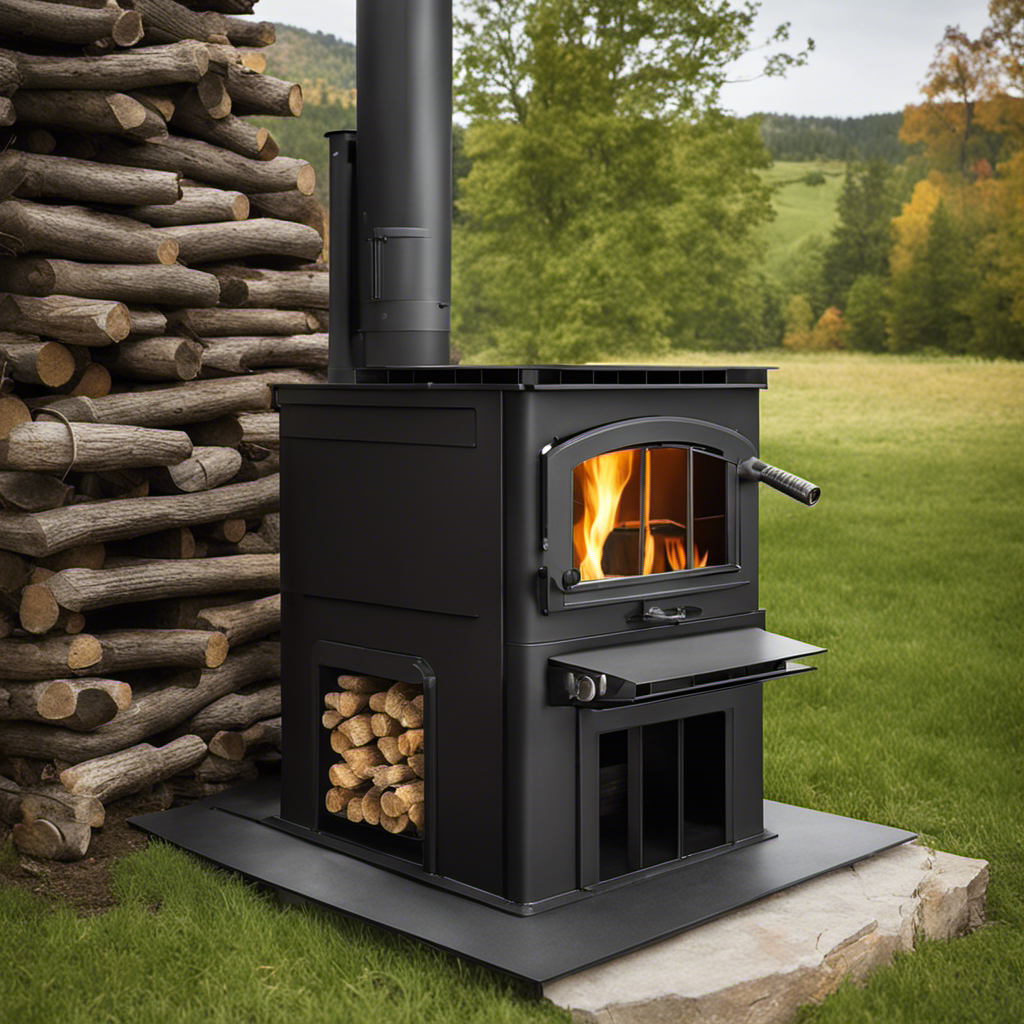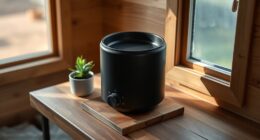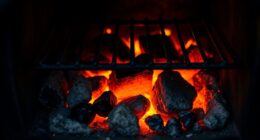So, you’ve gotten yourself a wood pellet stove, haven’t you? Well, you’re in luck because I’m on hand to show you the proper method for venting that remarkable device. Trust me, it’s easier than it looks.
In this step-by-step guide, I’ll walk you through everything you need to know to ensure your wood pellet stove is ventilated correctly. From assessing the ventilation needs to troubleshooting common issues, I’ve got you covered.
Let’s get started and make sure your cozy evenings by the fire are safe and efficient.
Key Takeaways
- Assess room size, layout, and ventilation needs before choosing a venting system for a wood pellet stove.
- Follow manufacturer’s instructions and recommendations for proper installation and venting location.
- Use appropriate materials and measurements to ensure safety and efficiency.
- Regularly test, maintain, and ensure compliance with local building codes and regulations to prevent hazards and ensure safe and effective venting.
Step 1: Assessing the Ventilation Needs
Before you can begin installing the vent for your wood pellet stove, you’ll need to assess the ventilation needs of your space. This is an important step to ensure the proper functioning of your stove and to maintain a safe environment.
Start by evaluating the size of your room and the number of windows and doors present. Consider the height of the ceiling and the overall layout of the space. Assessing ventilation requirements involves determining the appropriate amount of fresh air intake and exhaust for your stove.
Once you have a clear understanding of your ventilation needs, you can move on to step 2: choosing the right venting system that will effectively meet those requirements and ensure optimal performance of your wood pellet stove.
Step 2: Choosing the Right Venting System
When it comes to venting systems for wood pellet stoves, there are a few options to consider.
The first option is a direct vent system, which allows for both the intake and exhaust to be vented directly outside.
The second option is a power vent system, which uses a fan to help push the exhaust gases out of the stove.
Lastly, there is the option of a natural draft system, which relies on the natural buoyancy of hot air to carry the exhaust gases out.
Proper installation of the venting system is crucial to ensure safety and efficiency. This involves following the manufacturer’s instructions, using the correct materials and measurements, and ensuring proper clearances from combustible materials.
Venting System Options?
There are several options for the venting system of a wood pellet stove. When it comes to venting system installation, it’s important to choose the right option for your specific needs.
Here are three options to consider:
-
Horizontal Venting: This option is suitable when the stove is installed on an exterior wall. It involves running the vent pipe horizontally through the wall to the outside.
-
Vertical Venting: This option is ideal for stove installations on upper floors or when the stove is not near an exterior wall. It requires running the vent pipe vertically through the ceiling and roof.
-
Direct Venting: This option is the most versatile and convenient. It involves using a pipe that can be installed horizontally or vertically, allowing more flexibility in stove placement.
Proper venting installation is crucial for the safe and efficient operation of your wood pellet stove. Now, let’s move on to discussing the steps for proper venting installation.
Proper Venting Installation
Proper venting installation is crucial to ensure the safe and efficient operation of your wood pellet stove. The type of venting system you choose will depend on various factors such as the layout of your home and the manufacturer’s recommendations.
There are two main types of venting systems commonly used for wood pellet stoves: direct vent and vent-free.
In a direct vent system, the stove is connected to a vertical vent pipe that runs through the wall or roof of your home. This type of system provides a dedicated air intake and exhaust, ensuring that the combustion process is isolated from the living space.
On the other hand, a vent-free system operates without a vent pipe and relies on the indoor air for combustion. While this option may be more convenient, it requires strict adherence to safety guidelines to prevent the buildup of harmful gases inside your home.
When determining the venting location for your wood pellet stove, it is important to consider proximity to combustible materials, clearances to walls and ceilings, and accessibility for cleaning and maintenance.
Step 3: Determining the Venting Location
To determine the venting location for your wood pellet stove, you’ll need to consider the proximity to an exterior wall. This is an important step in ensuring proper venting installation.
When determining venting requirements, there are several factors to consider.
First, assess the structural integrity of the wall. It should be able to support the weight of the vent pipe and the stove.
Additionally, consider the distance from combustible materials. The venting location should be away from any flammable substances.
Next, think about the path of the vent pipe. It should be as straight and short as possible to maximize efficiency and minimize the risk of blockages.
With these venting location factors in mind, you can now move on to step 4: installing the vent pipe seamlessly.
Step 4: Installing the Vent Pipe
Now that you have determined the venting location, it’s time to seamlessly install the vent pipe. This step is crucial for proper venting pipe installation and ensuring the efficient operation of your wood pellet stove. Follow these steps to install the vent pipe correctly:
-
Start by measuring the distance between the stove and the venting location. This will determine the length of the vent pipe needed.
-
Choose the appropriate vent pipe material, such as stainless steel or aluminum, that complies with local building codes.
-
Ensure the vent pipe is angled upwards slightly to allow for proper draft and prevent any condensation buildup.
-
Use appropriate connectors and sealing materials to secure the vent pipe sections together.
Transitioning to the subsequent section about connecting the vent pipe to the stove, it’s essential to follow the manufacturer’s instructions carefully to ensure a secure and leak-free connection.
Proper installation of the vent pipe is vital for the safe and efficient operation of your wood pellet stove.
Now let’s move on to connecting the vent pipe to the stove.
Step 5: Connecting the Vent Pipe to the Stove
Make sure you carefully read and follow the manufacturer’s instructions for a secure and leak-free connection when connecting the vent pipe to your stove. This step is crucial to ensure the proper functioning of your wood pellet stove.
Here are some connecting techniques and troubleshooting tips to help you with this process.
-
Begin by aligning the vent pipe with the exhaust flange on the stove. Ensure that the pipe is centered and level.
-
Use the appropriate connector, such as a twist-lock or clamp, to secure the vent pipe to the stove. Make sure it fits tightly to prevent any air leakage.
-
Double-check all connections to ensure they are secure. Wiggle the pipe gently to ensure it is properly seated.
-
If you encounter any issues, such as a loose connection or air leakage, refer to the manufacturer’s instructions or contact a professional for assistance.
Now that you have successfully connected the vent pipe to your stove, let’s move on to step 6: sealing and insulating the venting system.
Step 6: Sealing and Insulating the Venting System
In order to ensure the safe and efficient operation of a wood pellet stove, it is crucial to properly seal and insulate the venting system.
Proper sealing is important to prevent any leaks or gaps that could allow exhaust fumes to enter the living space.
Insulating the venting system helps to maximize heat efficiency by reducing heat loss and maintaining a consistent temperature.
When it comes to materials for effective sealing, it is recommended to use high-quality gaskets, sealants, and insulation materials that are specifically designed for use with wood pellet stoves.
Importance of Proper Sealing
Proper sealing is crucial for ensuring efficient and safe operation of a wood pellet stove. When it comes to venting, a well-sealed system is essential for maintaining energy efficiency and preventing air leaks.
Air leaks can result in heat loss, reduced stove performance, and increased energy consumption. To prevent these issues, it is important to use proper sealing techniques and materials.
One common technique is to use high-temperature silicone sealant to seal any gaps or joints in the venting system. This sealant is designed to withstand the high temperatures generated by the stove. Additionally, using metal tape or clamps to secure the joints can further enhance the sealing effectiveness.
By properly sealing the venting system, you can ensure optimal energy efficiency and minimize air leaks, leading to a more efficient and cost-effective wood pellet stove operation.
Now, let’s move on to the next section about insulation for heat efficiency.
Insulation for Heat Efficiency
To improve the heat efficiency of your home, you should consider adding insulation to your walls, attic, and floors. Proper insulation is essential in reducing heat loss and increasing energy efficiency. Here is a step-by-step guide on how to insulate your home:
-
Evaluate your current insulation: Check the R-value of your existing insulation and determine if it needs to be upgraded.
-
Choose the right insulation material: There are various options available, such as fiberglass, cellulose, and spray foam. Consider factors like cost, effectiveness, and ease of installation.
-
Insulate the walls: Install insulation batts or rolls between the wall studs, ensuring a snug fit without compression.
-
Insulate the attic: Lay insulation batts or blown-in insulation in the attic space, covering the entire floor area.
-
Insulate the floors: Install insulation batts or rolls beneath the floorboards or between the floor joists.
Materials for Effective Sealing
You can use weatherstripping and caulk to effectively seal any gaps or cracks in your windows and doors, improving the energy efficiency of your home.
When it comes to sealing techniques, there are a few key steps to follow.
First, inspect the windows and doors for any visible gaps or cracks.
Next, measure the size of the gaps to determine the amount of weatherstripping or caulk needed.
Choose the appropriate sealing materials based on the size and location of the gaps. For smaller gaps, weatherstripping is generally more suitable, while caulk is better for larger gaps or cracks.
Apply the weatherstripping or caulk carefully, ensuring a tight seal. Press it firmly into place, making sure there are no gaps or spaces.
Step 7: Testing the Ventilation Setup
Once the ventilation setup is complete, it’s time to test it out to ensure proper airflow for your wood pellet stove. Testing the ventilation system is crucial to ensure that the stove operates efficiently and safely. There are several testing methods and troubleshooting techniques that can be used to verify the functionality of the venting system.
To begin testing, make sure that all connections are secure and there are no visible leaks. Then, light the stove and observe the flame pattern. A steady and consistent flame indicates proper airflow. If the flame is weak or flickering, it could be a sign of restricted airflow or a blockage in the venting system.
Another testing method is to use a smoke pencil or incense stick near the joints and connections of the venting system. If the smoke is drawn into the pipe, it signifies proper ventilation. However, if the smoke is pushed out or lingers around, it indicates a problem that needs to be addressed.
In case you encounter any issues during testing, troubleshooting techniques can help identify and resolve the problem. Check for any obstructions or debris in the venting system and clean them if necessary. Additionally, ensure that the venting system meets the manufacturer’s specifications and guidelines.
Step 8: Maintaining and Cleaning the Venting System
Regular maintenance is crucial for the proper functioning and longevity of the venting system. To ensure optimal performance, it is important to follow a set of regular maintenance tips.
These tips include checking for any blockages or obstructions, inspecting the seals and gaskets, and cleaning the vents regularly. Establishing a cleaning schedule will help keep the venting system clean and free from debris. Regular cleaning will prevent clogs and maintain efficient airflow.
In addition to regular cleaning, it is highly advised to have professional inspections done periodically. These inspections will ensure the venting system is in good condition and address any potential issues before they escalate.
Regular Maintenance Tips
To keep your wood pellet stove running efficiently, it’s important to regularly clean the ash trap. Cleaning techniques for the ash trap are fairly straightforward.
First, ensure that the stove is turned off and has cooled down. Using a metal scoop, carefully remove the ashes from the trap and dispose of them in a metal container. Be sure not to overfill the container, as hot embers can remain.
Next, use a vacuum cleaner with a brush attachment to remove any remaining ash residue. If you notice that the ash trap is not collecting ashes properly or is becoming clogged, it may be a sign of a larger issue. Troubleshooting tips for this include checking the air intake and exhaust pipes for any blockages or obstructions.
Regularly cleaning the ash trap will help prevent such issues and ensure the proper functioning of your wood pellet stove.
Now, let’s move on to cleaning schedule recommendations…
Cleaning Schedule Recommendations
Make sure you establish a cleaning schedule that suits your specific needs and ensures the optimal performance of your appliance. Regular maintenance is crucial to keep your wood pellet stove working efficiently.
Here are some recommendations for your cleaning schedule:
- Clean the ash pan: Remove the ashes at least once a week to prevent buildup and maintain proper airflow.
- Clean the burn pot: Empty and clean the burn pot every two weeks to remove any ash or residue that may affect combustion.
- Clean the exhaust vent: Inspect and clean the exhaust vent annually or whenever you notice a decrease in stove performance.
To clean your wood pellet stove, you will need the following tools and supplies:
- Ash shovel
- Stove brush or vacuum cleaner with a brush attachment
- Glass cleaner for the viewing window
Importance of Professional Inspections
When it comes to ensuring the safety and optimal performance of your appliance, it’s crucial to have professional inspections conducted regularly. Professional inspections are essential for complying with safety regulations and identifying any potential issues with your venting system.
These inspections should be performed by trained technicians who are knowledgeable about the specific requirements for wood pellet stove venting. During the inspection, the technician will thoroughly examine the venting system, checking for any obstructions, leaks, or damage. They will also ensure that the venting system is properly installed and meets all safety standards.
By having professional inspections, you can have peace of mind knowing that your venting system is functioning safely and efficiently.
With that in mind, let’s move on to troubleshooting common venting issues.
Step 9: Troubleshooting Common Venting Issues
If you’re experiencing common venting issues with your wood pellet stove, there are a few troubleshooting steps you can take:
-
Check for blockages: Ensure that there are no obstructions in the vent pipe or chimney. If there’s any debris, remove it carefully.
-
Inspect the seals: Check the seals around the vent pipe and chimney to ensure they’re intact and properly sealed. Replace any damaged or worn-out seals.
-
Clean the stove: Regularly clean the stove and remove any ash or soot buildup that may be blocking the venting system.
-
Adjust the settings: If the stove isn’t venting properly, try adjusting the settings according to the manufacturer’s instructions.
By following these troubleshooting tips, you can identify and resolve common venting problems with your wood pellet stove.
Ensuring safety and compliance with regulations is the next important step in maintaining your stove’s performance.
Step 10: Ensuring Safety and Compliance With Regulations
Now that we have addressed common venting issues, let’s move on to the crucial step of ensuring safety and compliance with regulations when venting a wood pellet stove. Safety measurements and adherence to regulations are paramount to protect yourself and your home from potential hazards.
To help you understand the necessary safety precautions, I have created a table outlining important safety measurements and compliance regulations you should follow:
| Safety Measurements | Compliance with Regulations |
|---|---|
| Install carbon monoxide detectors near the stove and throughout your home | Follow local building codes and regulations for venting systems |
| Ensure proper clearance between the stove and combustible materials | Use venting materials approved by the stove manufacturer |
| Regularly inspect and clean the venting system to prevent blockages | Follow any specific guidelines provided by the stove manufacturer |
| Keep the area around the stove clear of any flammable objects | Have the venting system professionally inspected annually |
| Familiarize yourself with emergency procedures in case of a stove malfunction | Obtain any necessary permits or approvals before installing the venting system |
Are There Different Ways to Properly Vent a Wood Pellet Stove?
Yes, there are various methods to properly vent a wood pellet stove. A vent wood pellet stove tutorial can guide you through the options, such as venting through an existing chimney, using a direct vent system, or installing a power vent to expel the combustion gases. Each method has its own requirements and considerations.
Frequently Asked Questions
Can I Use the Same Venting System for Multiple Wood Pellet Stoves?
Yes, you can use the same venting system for multiple wood pellet stoves. Proper ventilation techniques and installation tips are crucial to ensure the safe and efficient operation of all the stoves connected to the system.
How Often Should I Clean the Venting System?
Cleaning frequency for a venting system depends on usage and environmental factors. Regular maintenance is crucial to ensure proper airflow and prevent blockages. Follow manufacturer’s guidelines and inspect the system annually for any signs of damage or buildup.
Can I Install the Vent Pipe Vertically?
Yes, you can install the vent pipe vertically, but it is not recommended. Installing it horizontally has numerous benefits, such as improved efficiency and easier maintenance. It is best to have a professional handle the installation process.
What Are the Potential Risks of Improper Venting?
Potential dangers of improper venting include carbon monoxide poisoning, fire hazards, and damage to the stove. To ensure safety, follow manufacturer’s guidelines, use proper ventilation materials, and have regular inspections and maintenance performed.
Are There Any Specific Regulations or Codes That I Need to Follow When Venting a Wood Pellet Stove?
When it comes to venting a wood pellet stove, it’s important to follow proper venting techniques and adhere to venting regulations. Failure to do so can result in safety hazards and potential code violations.
Conclusion
In conclusion, venting a wood pellet stove is a crucial step to ensure its efficient and safe operation. By following the steps outlined in this article, you can successfully install and maintain the venting system.
Remember to always assess your ventilation needs, choose the right venting system, and determine the proper location. Testing the setup and troubleshooting any issues are also important steps.
By keeping safety and compliance in mind throughout the process, you can enjoy the warmth and comfort of your wood pellet stove while minimizing any potential risks.
Growing up surrounded by the vast beauty of nature, Sierra was always drawn to the call of the wild. While others sought the comfort of the familiar, she ventured out, embracing the unpredictable and finding stories in the heartbeat of nature.
At the epicenter of every remarkable venture lies a dynamic team—a fusion of diverse talents, visions, and passions. The essence of Best Small Wood Stoves is crafted and refined by such a trio: Sierra, Logan, and Terra. Their collective expertise has transformed the platform into a leading authority on small wood stoves, radiating warmth and knowledge in equal measure.











